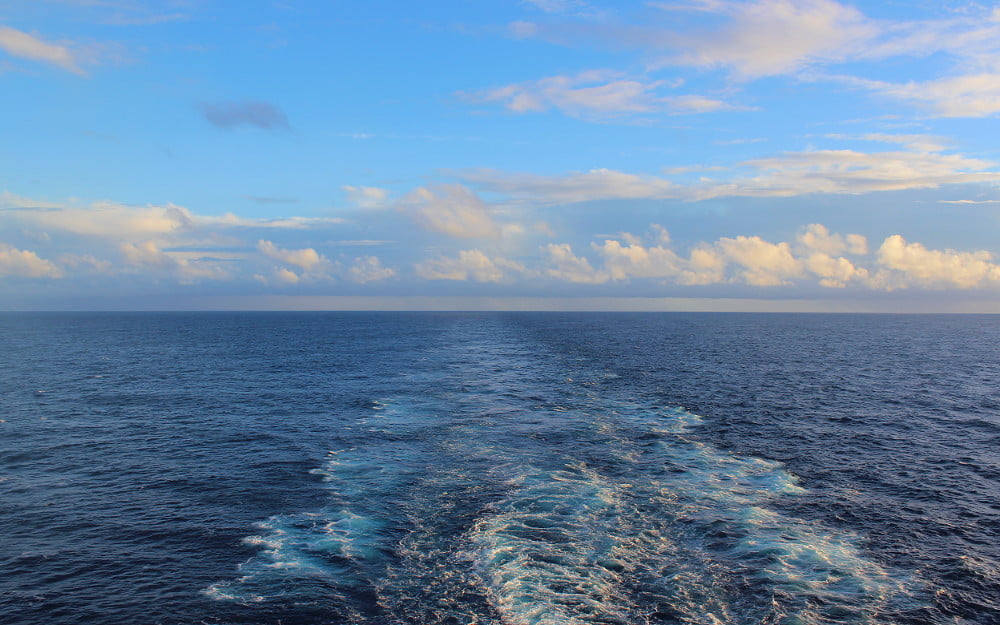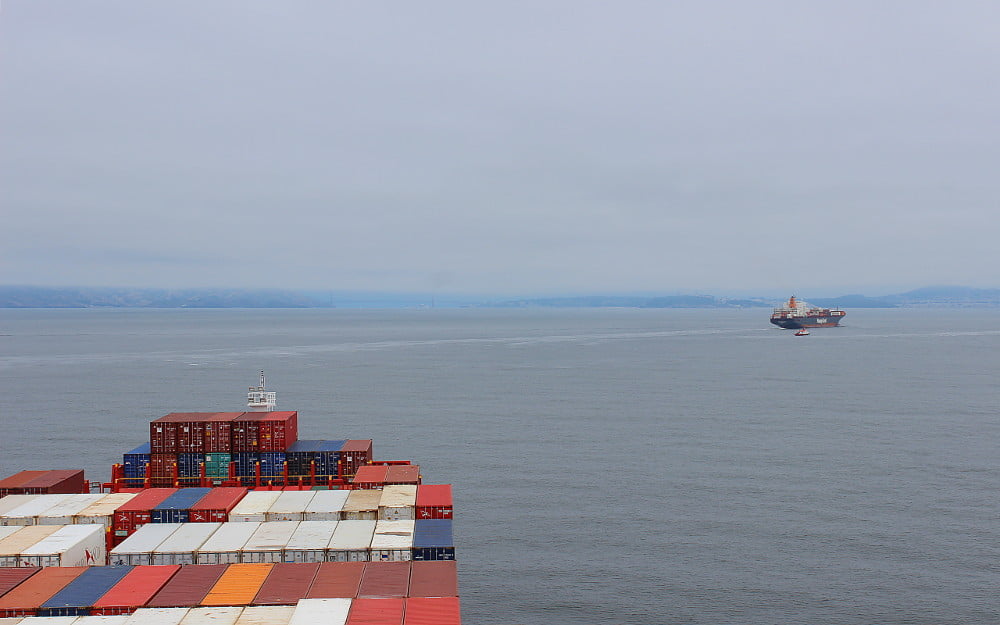How long does it take a cargo ship to cross the Atlantic? This article lists common cargo ship routes and their durations for crossing the Atlantic ocean.
A few months ago I published a blog post called “How Long Does It Take a Cargo Ship to Cross the Pacific?“. The popularity of my text surprised me. Dozens of people find it on Google every day, making it one of the most popular posts of my travel blog.
A few days ago, I realized I could serve even more people by writing a similar artice about the Atlantic. The ocean is different, but the format of these two posts is identical.
Because this is a travel blog, I’m focusing on cargo ship routes that take passengers. And because I’ve only crossed the Pacific on a cargo ship, all the pictures are from the wrong ocean. Don’t let that disturb you.
Most of you are not interested in just freighters. Instead, you want to know how long it takes a ship to cross the Atlantic. I’m covering travel durations for different types of ships at the end of the post.

How long does it take a cargo ship to cross the Atlantic?
How Long Does It Take a Cargo Ship to Cross the Atlantic?
It usually takes around 10-20 days to cross the Atlantic Ocean on a cargo ship. The length of the journey depends on the route and the speed of the container ship.
Here are a few examples of popular (or otherwise interesting) Transatlantic cargo ship routes and their approximate durations:
Le Havre (France) – New York (USA) = 9 days
If there are no extra stops along the way, it is possible to cross from Europe to USA on a cargo ship in less than ten days.
Source: Freightercruises.com
Natal (Brazil) – Algeriza (Spain) = 10 days
Source: Freightercruises.com
Liverpool (England) – Wilmington (North Carolina, USA) = 13 days
The container ships on this route stop in Chester (England) on the way.
Source: Cargoshipvoyages.com
Rotterdam (Netherlands) – Port of Spain (Trinidad, Southern Caribbean) = 14 days
The container ships on this route make stops in Le Havre, France (day 2) and Philipsburg, Sint Maarten in the Caribbean (day 13).
Source: Freightercruises.com
Le Havre (France) – Veracruz (Mexico) = 20 days
Source: Cargoshipvoyages.com
Hamburg (Germany) – Valpraiso (Chile) ≈ 34 days
It’s also possible to travel through Panama Channel to the Pacific. This epic freighter voyage from Germany all the way to Chile also makes stops in Dominican Republic, Colombia, Panama, Ecuador and Peru. On the way back it only stops in Panama and the Netherlands.
Source: Freighterexpeditions.com

On the deck of a cargo ship.
Why are there no freighter routes to/from Africa on the list?
Because I couldn’t find any! I wanted to take a cargo ship from South America to South Africa on my current 2-year trip around the world, but I haven’t seen any offers for the route.
If you look for cargo ship routes across the Atlantic, you’ll soon notice that cargo ships don’t go everywhere. Instead, they follow a few popular routes between big ports.
The freighters mostly go to rich countries with international trade (such as USA) or ports with central location (such as Panama).
How exact are the durations of these cargo ship voyages across the Atlantic?
The schedules of the container ships are always just estimations. The departure dates can shift by a day or two. The same thing applies for the length of the journey.
When I crossed the Pacific from New Zealand to California, our departure was delayed by two days. Still, our arrival time wasn’t affected.
Why are the cargo ships across the Atlantic so slow?
Does crossing the Atlantic in 10-20 days seems like a surprisingly long time? There’s a reason for it.
When RMS Titanic hit that iceberg over a hundred years ago, the ship was cruising at a speed above 22 knots (41 km/h, 25 mph). Although marine technology has developed since then, cargo ships usually travel at much slower speeds.
Why? The reason for slower seafaring is fuel. Titanic and other ships of its time traveled close to their maximum speed. However, modern freighter companies save fuel costs by traveling at slower speeds such 12 or 20 knots (22 or 37 km/h, 14 or 23 mph).
What about other ships? How long does it take a ship to cross the Atlantic?
Cruise ships travel a little bit faster than freighters, traveling at a speed of 20 to 25 knots (37-46 km/h, 23-29 mph). Crossing the Atlantic on a cruise may take around 6 to 8 days. The trip may take longer if there are more ports of call on the way.
Sailing boats are a lot slower and usually travel at a speed of 4-6 knots (7-11 km/h, 5-7 mph). Sailing across the Atlantic Ocean may take 3-4 weeks.

A slow-speed chase.
Now that I’ve covered both how long it takes a cargo ship to cross the Atlantic and the Pacific, I’ll finish this article with something bigger. In case you’ve ever wondered how long does it take a cargo ship to circumnavigate around the world, here’s the answer:
How long would it take to travel around the world on a cargo ship?
According to Freightercruises.com, traveling around the world on a cargo ship can be done in approximately 77 days. Their RTW route goes through both Panama Canal and Suez Canal. The cargo ships stop in ports in Eastern USA, Singapore, China and South Korea.
* * *
If you’re planning to travel across the Atlantic on a cargo ship, I can also recommend reading my post “How to Prepare for Traveling on a Cargo Ship?“





14 comments
Hi, I’d like to know if any international treaty allows ships to navigate from the Panama Canal to the US east coast through Cuban waters, of if they exit the Caribbean Sea just by crossing the Mona Passage or others alike in the Lesser Antilles. Thanks.
Hi Vivian, unfortunately I don’t know!
Thanks Arimo for the blog. I am doing research for the sequel to my novel, Mind Duel. My heroine, Dr. Kim Lake, and her crew need to travel surreptitiously from Florida to Africa with their bulky equipment. The internet makes research too easy for a writer these days!
Thank you Tom – and good luck with your writing! 🙂
How long is the Voyage from Rotterdam to Mexican (translantic Voyage) Tanker. Thank you
(transatlantic) tanker vessel
Hey Antoniette! Such voyage would take about 20 days.
Hi Arimo
I’m exploring the possibility of loading some “tiny home converted containers” to cross the Atlantic by boat, cross North America by train, cross the Pacific by boat, and then? All the way back to Europe. Would you be interested in participating?
Look forward to hearing from you.
All the best
Harold
Hi Harold!
Right now I’m enjoying settling down without traveling, but thank you for the invitation. 🙂
Chester is in England
Thanks for the correction Steve, I fixed that now!
It can take an average of three to four weeks to cross the Atlantic. You can cut it to two weeks if you know all about winds and currents. These wind patterns can help you chart your course efficiently.